Atangana-Baleanu Fractional Dynamics of Predictive Whooping Cough Model with Optimal Control Analysis
Abstract
:1. Introduction
2. Model Formulation
- : Recruitment rate of the susceptible.
- : Natural death rate of individuals of each compartment.
- : Rate of contact of the susceptible with infectious people.
- : Rate at which the susceptible are vaccinated.
- : Rate of contact of vaccinated with infectious people.
- : Rate at which the exposed become infectious.
- : Rate at which vaccinated people recovered.
- : Rate at which infectious people recovered.
- : Rate at which infectious people are quarantined.
- : Rate at which exposed people are quarantined.
- : Rate at which quarantined people recovered.
- : Death rate of infected people due to the disease.
- : Death rate of quarantined people due to the disease.
Fractional Model
3. Theoretical Analysis of the Proposed Model
3.1. Existence and Uniqueness of Solution
3.2. Boundedness and Positivity of the Solutions
3.3. Equilibrium Points and Threshold Parameter
3.3.1. Disease Free Equilibrium Point
3.3.2. Reproduction Number
3.3.3. Endemic Equilibrium
3.4. Stability Analysis
3.4.1. Local Stability
3.4.2. Global Stability
4. Numerical Investigations and Implementations
4.1. Toufik–Atangana Discretizations
Fractional Order Effect on Disease Dynamics
4.2. Quarantining Effects on Disease Dynamics
4.2.1. Effect of
4.2.2. Effect of
4.3. Vaccination Effect on Disease Dynamics
5. Sensitivity Analysis
6. Optimization of the Whooping Cough Model
6.1. Optimal Control Problem and Optimality Conditions
6.2. Solution Algorithm
| Algorithm 1: Algorithm to find minimizer of the control problem (28) |
|
6.3. Optimal Solutions
6.3.1. Optimal Vaccination Rate
6.3.2. Optimal Quarantine Rates
6.3.3. Optimal Vaccination and Quarantine Rates
7. Conclusions
Funding
Data Availability Statement
Acknowledgments
Conflicts of Interest
References
- Bokhari, H.; Said, F.; Syed, M.A.; Mughal, A.; Kazi, Y.F.; Heuvelman, K.; Mooi, F.R. Whooping cough in Pakistan- Bordetella Pertussis vs Bordetella Parapertussis in 2005–2009. Scand. J. Infect. Dis. 2011, 47, 1–3. [Google Scholar] [CrossRef] [PubMed]
- Joshi, H.R.; Lenhart, S.; Li, M.Y.; Wang, L. Optimal control methods applied to disease models in the mathematical studies on human disease dynamics. Contemp. Math. 2006, 410, 187–207. [Google Scholar]
- CDC Report on Pertussis (Whooping Cough) in Other Countries. Available online: https://www.cdc.gov/pertussis/countries/index.html (accessed on 4 August 2022).
- Alqarni, M.M.; Nasir, A.; Alyami, M.A.; Raza, A.; Awrejcewicz, J.; Rafiq, M.; Ahmed, N.; Shaikh, T.S.; Mahmoud, E.E. A SEIR epidemic model of whooping cough-like infections and its dynamically consistent approximation. Hindawi Complex. 2022, 2022, 3642444. [Google Scholar] [CrossRef]
- Obaidat, S.; Elrish, M.R.A.; Mesloub, S. A second order scheme for the numerical solution of a whooping cough model. J. Comput. Theor. Nanosci. 2017, 14, 4352–4360. [Google Scholar] [CrossRef]
- Van Bellinghen, L.A.; Dimitroff, A.; Haberl, M.; Li, X.; Manton, A.; Moeremans, K.; Demarteau, N. Is adding maternal vaccination to prevent whooping cough cost effective in Australia? Hum. Vaccines Immunother. 2018, 14, 2263–2277. [Google Scholar] [CrossRef] [PubMed]
- Suleman, M. An optimal control of vaccination applied to whooping cough model. J. Math. 2019, 51, 121–136. [Google Scholar]
- Ameri, K.; Cooper, K.D. A Network-Based compartmental model for the spread of whooping cough in Nebraska. AMIA Summits Transl. Sci. Proc. 2019, 2019, 388. [Google Scholar] [PubMed]
- Jena, R.M.; Chakraverty, S.; Jena, S.K. Analysis of the dynamics of phytoplankton nutrient and whooping cough models with nonsingular kernel arising in the biological system. Chaos Solitons Fractals 2020, 141, 110373. [Google Scholar] [CrossRef]
- Farman, M.; Akgül, A.; Tekin, M.T.; Akram, M.M.; Ahmad, A.; Mahmoud, E.E.; Yahia, I.S. Fractal fractional-order derivative for HIV/AIDS model with Mittag-Leffler kernel. Alex. Eng. J. 2022, 61, 10965–10980. [Google Scholar] [CrossRef]
- Diethelm, K. A fractional calculus based model for the simulation of an outbreak of dengue fever. Nonlinear Dyn. 2013, 71, 613–619. [Google Scholar] [CrossRef]
- Sabbar, Y.; Din, A.; Kiouach, D. Influence of fractal-fractional differentiation and independent quadratic Levy jumps on the dynamics of a general epidemic model with vaccination strategy. Chaos Solitons Fractals 2023, 171, 113434. [Google Scholar] [CrossRef]
- Khan, M.A.; Atangana, A. Modeling the dynamics of novel Coronavirus (2019-nCov) with fractional derivative. Alex. Eng. J. 2020, 59, 2379–2389. [Google Scholar] [CrossRef]
- Shah, N.A.; Vieru, D.; Fetecau, C. Effects of the fractional order and magnetic field on the blood flow in cylindrical domains. J. Magn. Megnetic Mater. 2016, 409, 10–19. [Google Scholar] [CrossRef]
- Ahmad, S.; Ullah, A.; Akgül, A.; Baleanu, D. Analysis of the fractional tumour-immune-vitamins model with Mittag–Leffler kernel. Results Phys. 2020, 19, 103559. [Google Scholar] [CrossRef]
- Podlubny, I. Fractional Differential Equations: An Introduction to Fractional Derivatives, Fractional Differential Equations, to Methods of Their Solution and Some of Their Applications; Elsevier: Amsterdam, The Netherlands, 1998. [Google Scholar]
- Akgül, A. A novel method for a fractional derivative with non-local and non-singular kernel. Chaos Solitons Fractals 2018, 114, 478–482. [Google Scholar] [CrossRef]
- Naim, M.; Sabbar, Y.; Zeb, A. Stability characterization of a fractional-order viral system with the non-cytolytic immune assumption. Math. Model. Numer. Simul. Appl. 2022, 2, 164–176. [Google Scholar] [CrossRef]
- Dineshkumar, C.; Udhayakumar, R.; Vijayakumar, V.; Nisar, K.S.; Shukla, A.; Abdel-Aty, A.H.; Mahmoud, M.; Mahmoud, E.E. A note on existence and approximate controllability outcomes of Atangana-Baleanu neutral fractional stochastic hemivariational inequality. Results Phys. 2022, 38, 105647. [Google Scholar] [CrossRef]
- Ma, Y.K.; Dineshkumar, C.; Vijayakumar, V.; Udhayakumar, R.; Shukla, A.; Nisar, K.S. Approximate controllability of Atangana-Baleanu fractional neutral delay integrodifferential stochastic systems with nonlocal conditions. Ain Shams Eng. J. 2023, 14, 101882. [Google Scholar] [CrossRef]
- Shah, N.A.; Alyousef, H.A.; El-Tantawy, S.A.; Shah, S.; Chung, J.D. Analytical Investigation of Fractional-Order Korteweg–De-Vries-Type Equations under Atangana–Baleanu–Caputo Operator: Modeling Nonlinear Waves in a Plasma and Fluid. Symmetry 2022, 14, 739. [Google Scholar] [CrossRef]
- Shah, N.A.; Wakif, A.; Shah, R.; Yook, S.J.; Salah, B.; Mahsud, Y.; Hussain, K. Effects of fractional derivative and heat source/sink on MHD free convection flow of nanofluids in a vertical cylinder: A generalized Fourier’s law model. Case Stud. Therm. Eng. 2021, 28, 101518. [Google Scholar] [CrossRef]
- Berhe, H.W.; Qureshi, S.; Shaikh, A.A. Deterministic modeling of dysentery diarrhea epidemic under fractional Caputo differential operator via real statistical analysis. Chaos Solitons Fractals 2020, 131, 109536. [Google Scholar] [CrossRef]
- Samko, S.G.; Kilbas, A.A.; Marichev, O.I. Fractional Integrals and Derivatives: Theory and Applications; Gordon and Breach Science Publishers: Montreux, Switzerland; Philadelphia, PA, USA, 1993. [Google Scholar]
- Caputo, M.; Fabrizio, M. A new definition of fractional derivative without singular kernel. Progr. Fract. Differ. Appl. 2015, 1, 1–13. [Google Scholar]
- Baleanu, D.; Jajarmi, A.; Mohammadi, H.; Rezapour, S. A new study on the mathematical modelling of human liver with Caputo-Fabrizio fractional derivative. Chaos Solitons Fractals 2020, 134, 109705. [Google Scholar] [CrossRef]
- Khan, T.; Ullah, R.; Zaman, G.; Alzabut, J. A mathematical model for the dynamics of SARS-CoV-2 virus using the Caputo-Fabrizio operator. Math. Biosci. Eng. 2021, 18, 6095–6116. [Google Scholar] [CrossRef] [PubMed]
- Butt, A.I.K.; Imran, M.; Batool, S.; AL Nuwairan, M. Theoretical Analysis of a COVID-19 CF-Fractional Model to Optimally Control the Spread of Pandemic. Symmetry 2023, 15, 380. [Google Scholar] [CrossRef]
- Hanif, A.; Butt, A.I.K.; Ahmad, W. Numerical approach to solve Caputo-Fabrizio fractional model of corona pandemic with optimal control design and analysis. Math. Methods Appl. Sci. 2023, 46, 9751–9782. [Google Scholar] [CrossRef]
- Kilbas, A.A.; Srivastava, H.M.; Trujillo, J.J. Theory and Applications of Fractional Differential Equations; North-Holland Mathematics Studies: Amsterdam, The Netherlands, 2006. [Google Scholar]
- Atangana, A.; Balneau, D. New fractional derivative with nonlocal and nonsingular kernel: Theory and application to heat transfer model. Appl. Heat Transf. Model 2016, 20, 763–769. [Google Scholar]
- Hanif, A.; Butt, A.I.K. Atangana-Baleanu fractional dynamics of dengue fever with optimal control strategies. AIMS Math. 2023, 8, 15499–15535. [Google Scholar] [CrossRef]
- Butt, A.I.K.; Ahmad, W.; Rafiq, M.; Baleanu, D. Numerical analysis of Atangana-Baleanu fractional model to understand the propagation of a novel corona virus pandemic. Alex. Eng. J. 2022, 61, 7007–7027. [Google Scholar] [CrossRef]
- Ullah, S.; Khan, M.A.; Farooq, M.; Alzahrani, E.O. A fractional model for the dynamics of tuberculosis (TB) using Atangana-Baleanu derivative. Discrete Cont. Dyn. Syst.-S 2019, 13, 937–956. [Google Scholar] [CrossRef]
- Khan, M.A.; Ullah, S.; Farooq, M. A new fractional model for tuberculosis with relapse via Atangana-Baleanu derivative. Chaos Solitons Fractals 2018, 116, 227–238. [Google Scholar] [CrossRef]
- Qureshi, S.; Memon, Z.N. Monotonically decreasing behavior of measles epidemic well captured by Atangana-Baleanu-Caputo fractional operator under real measles data of Pakistan. Chaos Solitons Fractals 2020, 131, 109478. [Google Scholar] [CrossRef]
- Hanif, A.; Butt, A.I.K.; Ahmad, S.; Din, R.U.; Inc, M. A new fuzzy fractional order model of transmission of COVID-19 with quarantine class. Eur. Phys. J. Plus 2021, 136, 1–28. [Google Scholar] [CrossRef] [PubMed]
- Asamoah, J.K.K. Fractal fractional model and numerical scheme based on Newton polynomial for Q fever disease under Atangana-Baleanu derivative. Results Phys. 2022, 34, 105189. [Google Scholar] [CrossRef]
- Losada, J.; Nieto, J.J. Properties of a fractional derivative without singular kernel. Prog. Fract. Diff. Appl. 2015, 1, 87–92. [Google Scholar]
- Ullah, S.; Khan, M.A.; Farooq, M. A fractional model for the dynamics of tuberculosis virus. Chaos Solitons Fractals 2018, 116, 63–71. [Google Scholar] [CrossRef]
- Baleanu, D.; Ghassabzade, F.A.; Nieto, J.J.; Jajarmi, A. On a new and generalized fractional model for a real cholera outbreak. Alex. Eng. J. 2022, 61, 9175–9186. [Google Scholar] [CrossRef]
- Razia, B.; Osman, T.; Khan, H.; Haseena, G.; Khan, A. A fractional order Zika virus model with Mittag-Leffler kernel. Chaos Solitons Fractals 2021, 146, 110898. [Google Scholar]
- Atangana, A.; Koca, I. Chaos in a simple nonlinear system with Atangana-Baleanu derivative with fractional order. Chaos Solitons Fractals 2016, 89, 447–454. [Google Scholar] [CrossRef]
- Ahmad, W.; Abbas, M. Effect of quarantine on transmission dynamics of Ebola virus epidemic: A mathematical analysis. Eur. Phys. J. Plus 2021, 136, 1–33. [Google Scholar] [CrossRef]
- Ammi, M.R.S.; Zinihi, A.; Raezah, A.A.; Sabbar, Y. Optimal control of a spatiotemporal SIR model with reaction-diffusion involving p-Laplacian operator. Results Phys. 2023, 52, 106895. [Google Scholar] [CrossRef]
- Ali, I.; Khan, S.U. Threshold of Stochastic SIRS Epidemic Model from Infectious to Susceptible Class with Saturated Incidence Rate Using Spectral Method. Symmetry 2022, 14, 1838. [Google Scholar] [CrossRef]
- Ali, I.; Khan, S.U. Dynamics and simulations of stochastic COVID-19 epidemic model using Legendre spectral collocation method. AIMS Math. 2023, 8, 4220–4236. [Google Scholar] [CrossRef]
- Butt, A.I.K.; Batool, S.; Imran, M.; AL Nuwairan, M. Design and analysis of a new COVID-19 model with comparative study of control strategies. Mathematics 2023, 11, 1978. [Google Scholar] [CrossRef]
- Butt, A.I.K.; Chamaleen, D.B.D.; Batool, S.; AL Nuwairan, M. A new design and analysis of optimal control problems arising from COVID-19 outbreak. Math. Methods Appl Sci. 2023. [Google Scholar] [CrossRef]
- Butt, A.I.K.; Rafiq, M.; Ahmad, W.; Ahmad, N. Implementation of a computationally efficient numerical approach to analyze a COVID-19 pandemic model. Alex. Eng. J. 2023, 69, 341–362. [Google Scholar] [CrossRef]
- Butt, A.I.K.; Ahmad, W.; Rafiq, R.; Ahmad, N.; Imran, I. Computationally efficient optimal control analysis for the mathematical model of Coronavirus pandemic. Expert Syst. Appl. 2023, 234, 121094. [Google Scholar] [CrossRef]
- Van Den Drissche, P. Reproduction numbers of infectious disease models. Infect. Dis. Model. 2017, 2, 288–303. [Google Scholar] [CrossRef]
- Ahmad, W.; Rafiq, M.; Abbas, M. Mathematical analysis to control the spread of Ebola virus epidemic through voluntary vaccination. Eur. Phys. J. Plus 2020, 135, 775. [Google Scholar] [CrossRef]
- Kreyszig, E. Introductory Functional Analysis with Applications; John Wiley and Sons: New York, NY, USA, 1993. [Google Scholar]
- Arnold, V.I. Ordinary Differential Equations; MIT Press: London, UK, 1998. [Google Scholar]
- Diekmann, O.; Heesterbeek, J.A.P.; Metz, J.A. On the definition and the computation of the basic reproduction ratio R0 in models for infectious diseases in heterogeneous populations. J. Math. Biol. 1990, 28, 365–382. [Google Scholar] [CrossRef]
- Castillo-Chavez, C.; Feng, Z.; Huanz, W.; Driessche, P.V.D.; Kirschner, D.E. On the computation of R0 and its role in global stability. In Mathematical Approaches for Emerging and Reemerging Infectious Diseases: An Introduction; Springer: Berlin/Heidelberg, Germany, 2002. [Google Scholar]
- Toufik, M.; Atangana, A. New numerical approximation of fractional derivative with nonlocal and non-singular kernel: Application to chaotic models. Eur. Phys. J. Plus 2017, 132, 444. [Google Scholar] [CrossRef]
- Kamocki, R. Pontryagin maximum principle for fractional ordinary optimal control problems. Math. Methods Appl. Sci. 2014, 37, 1668–1686. [Google Scholar] [CrossRef]
- Lenhart, S.; Workman, J.T. Optimal Control Applied to Biological Models; CRC Press: Boca Raton, FL, USA, 2007. [Google Scholar]
- Ali, H.M.; Pereira, F.L.; Gama, S.M. A new approach to the Pontryagin maximum principle for nonlinear fractional optimal control problems. Math. Methods Appl. Sci. 2016, 39, 3640–3649. [Google Scholar] [CrossRef]
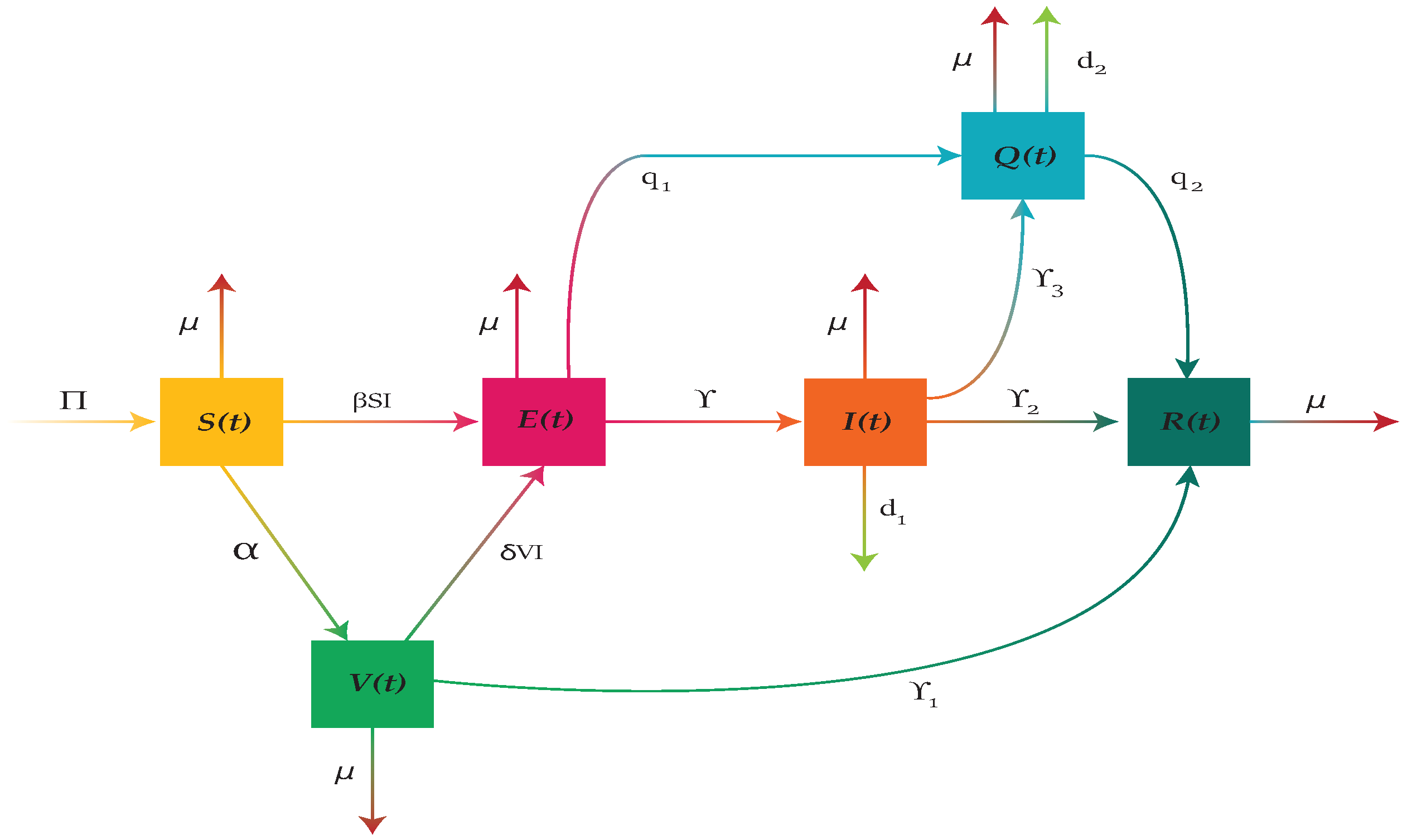

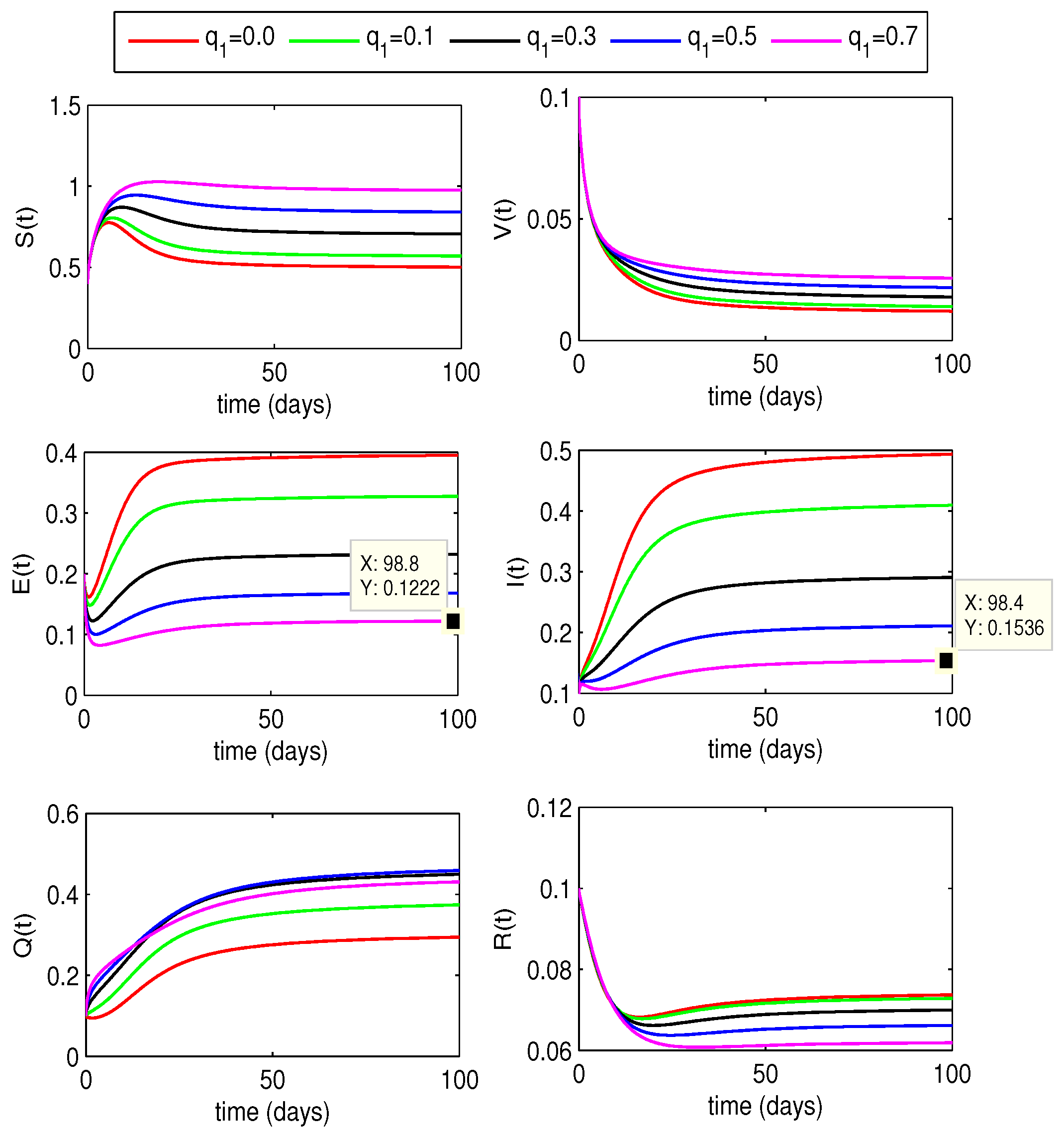
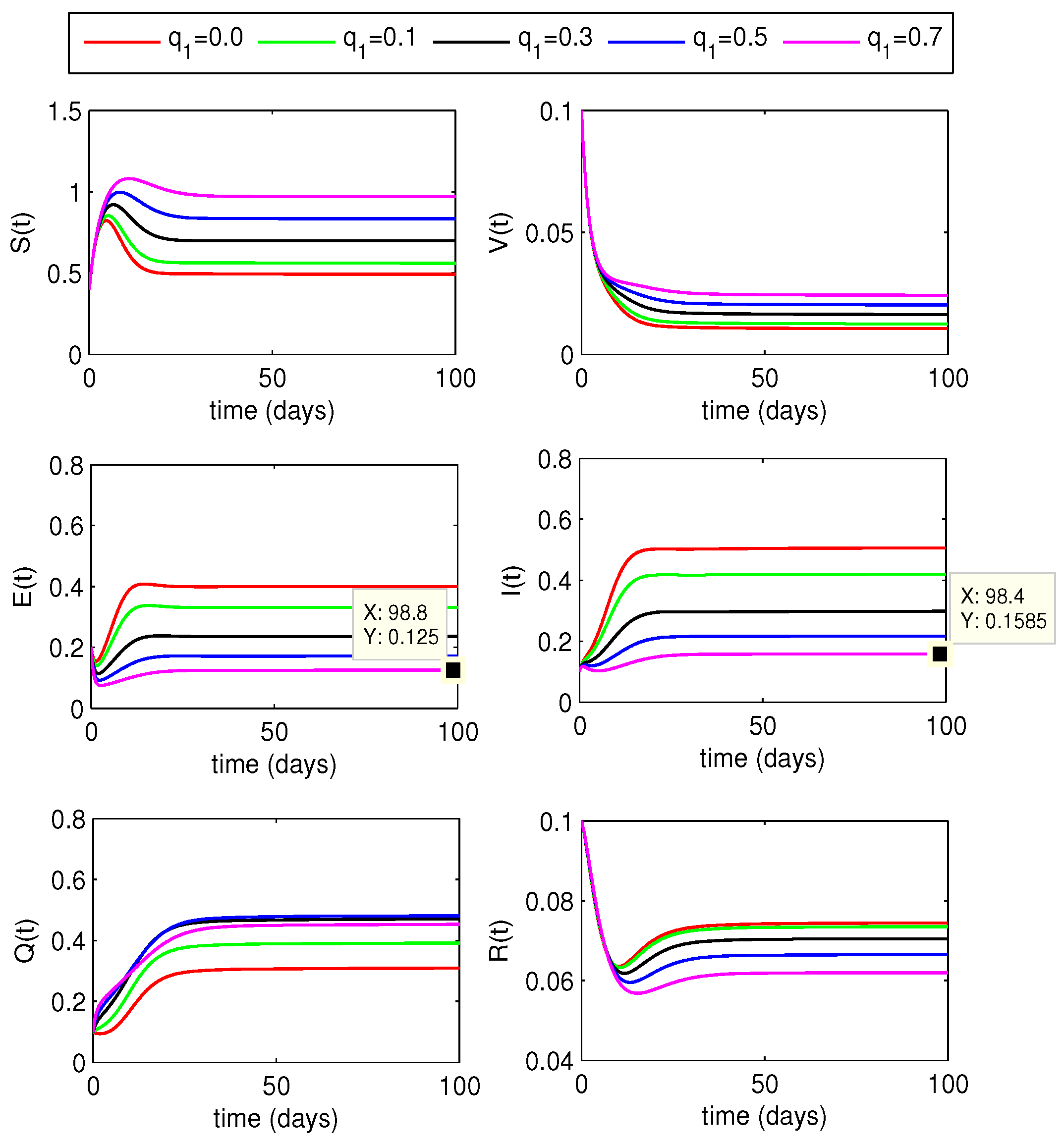
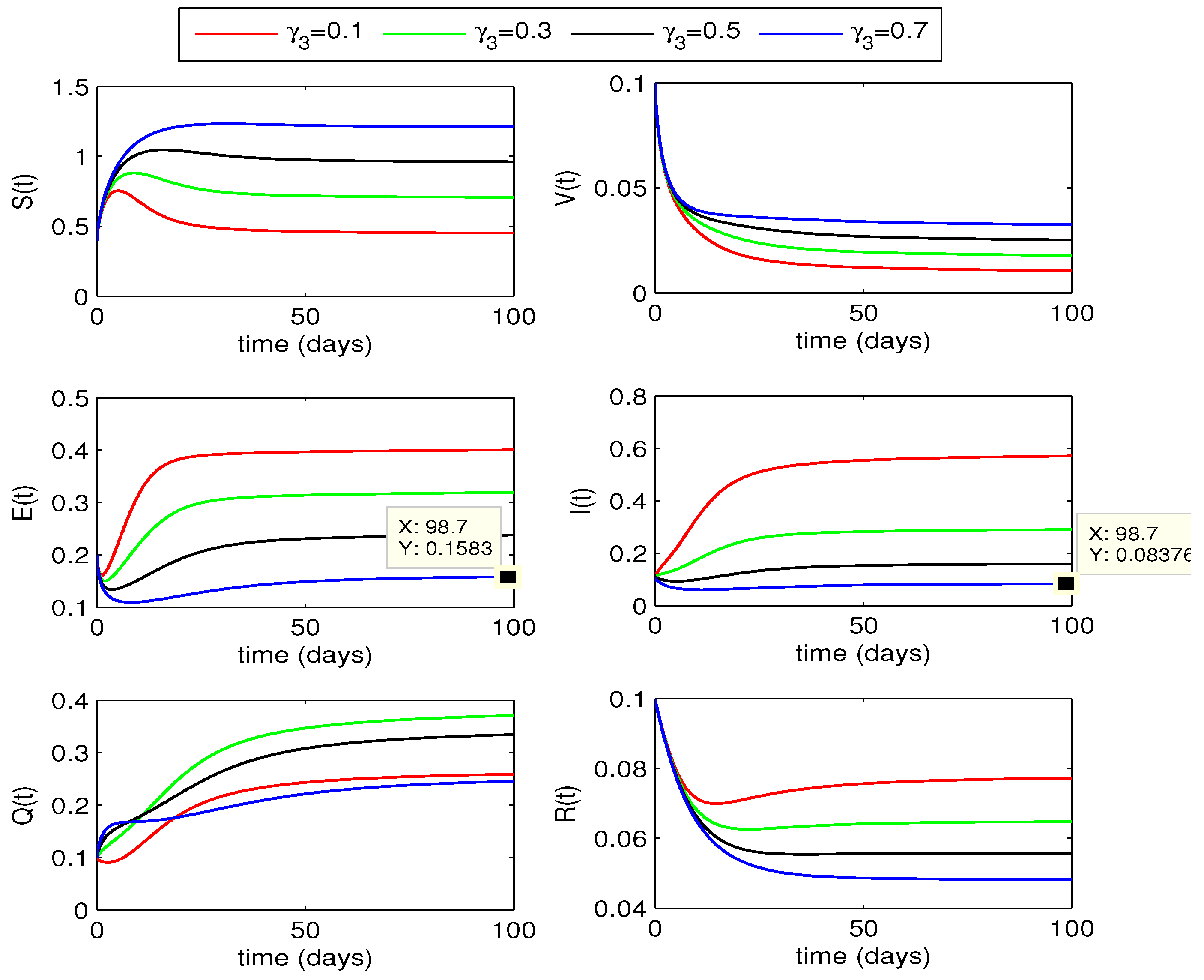
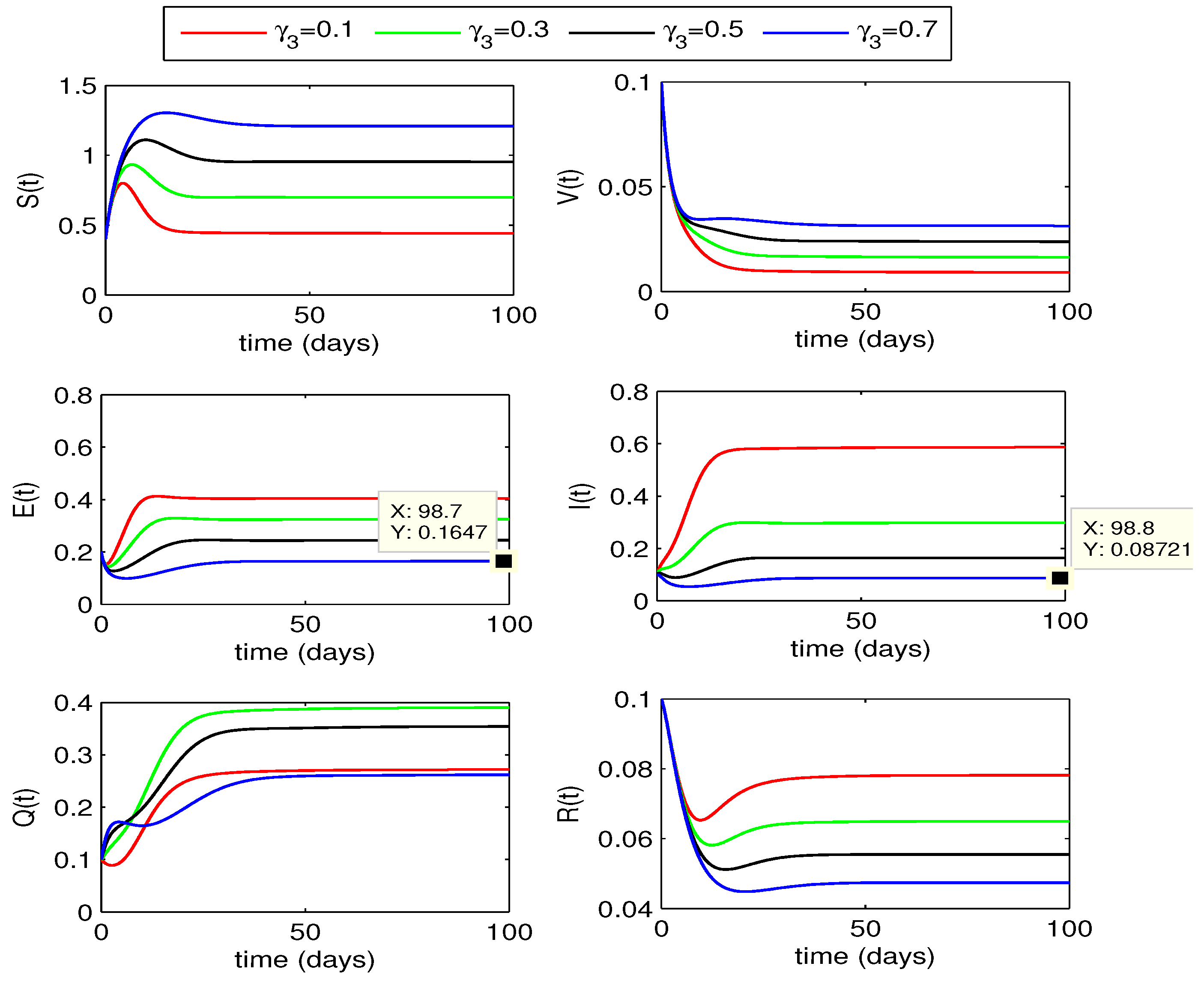
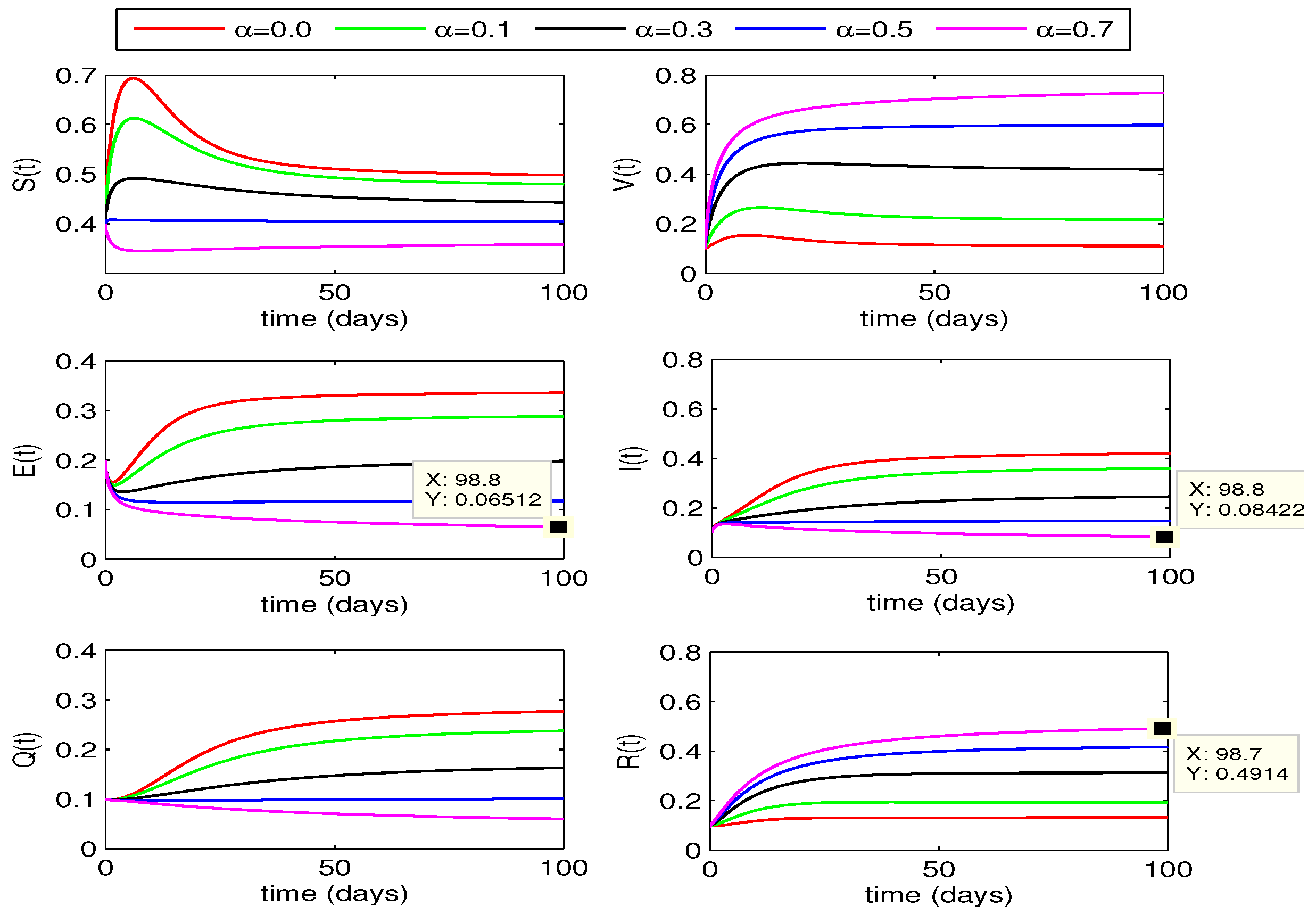

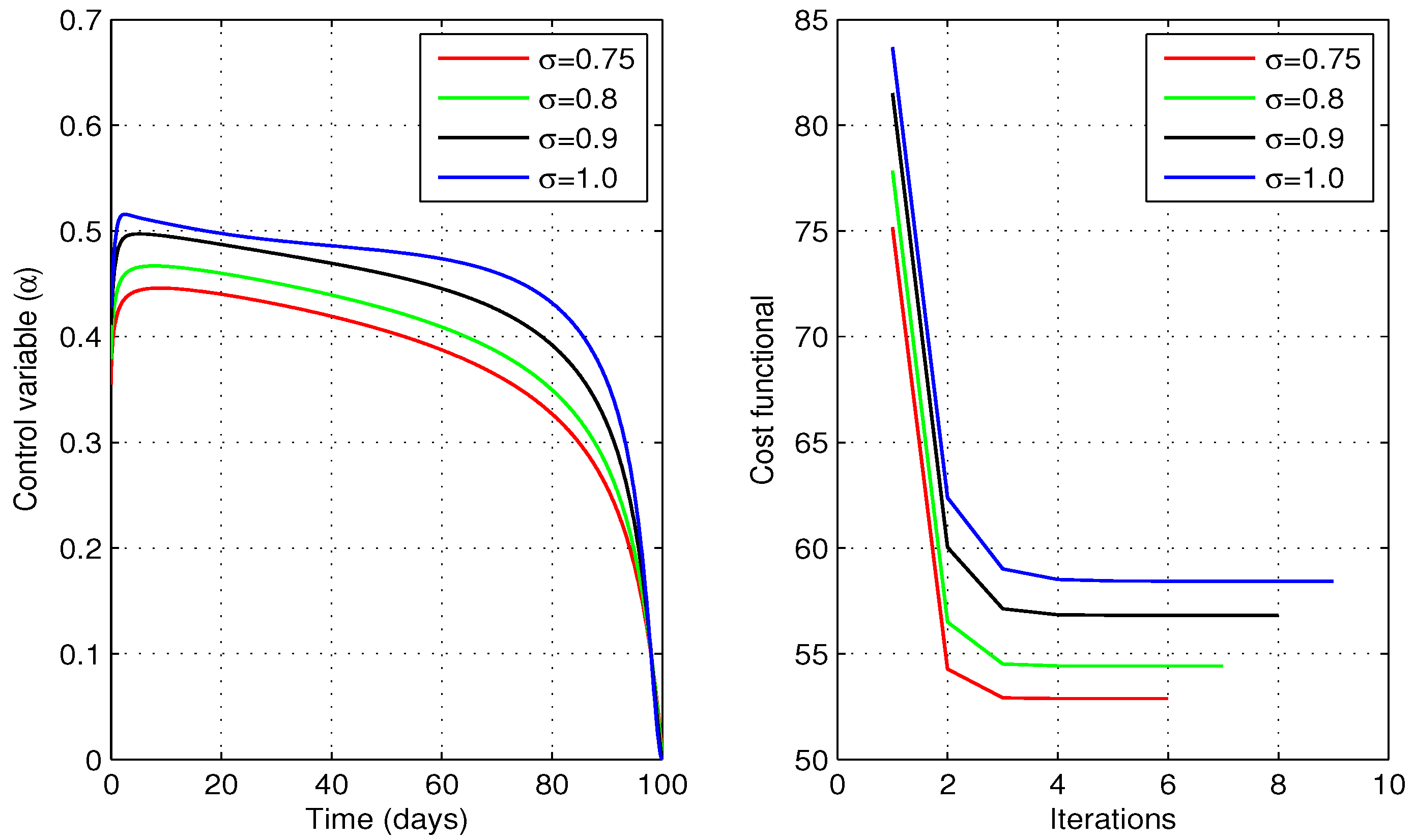
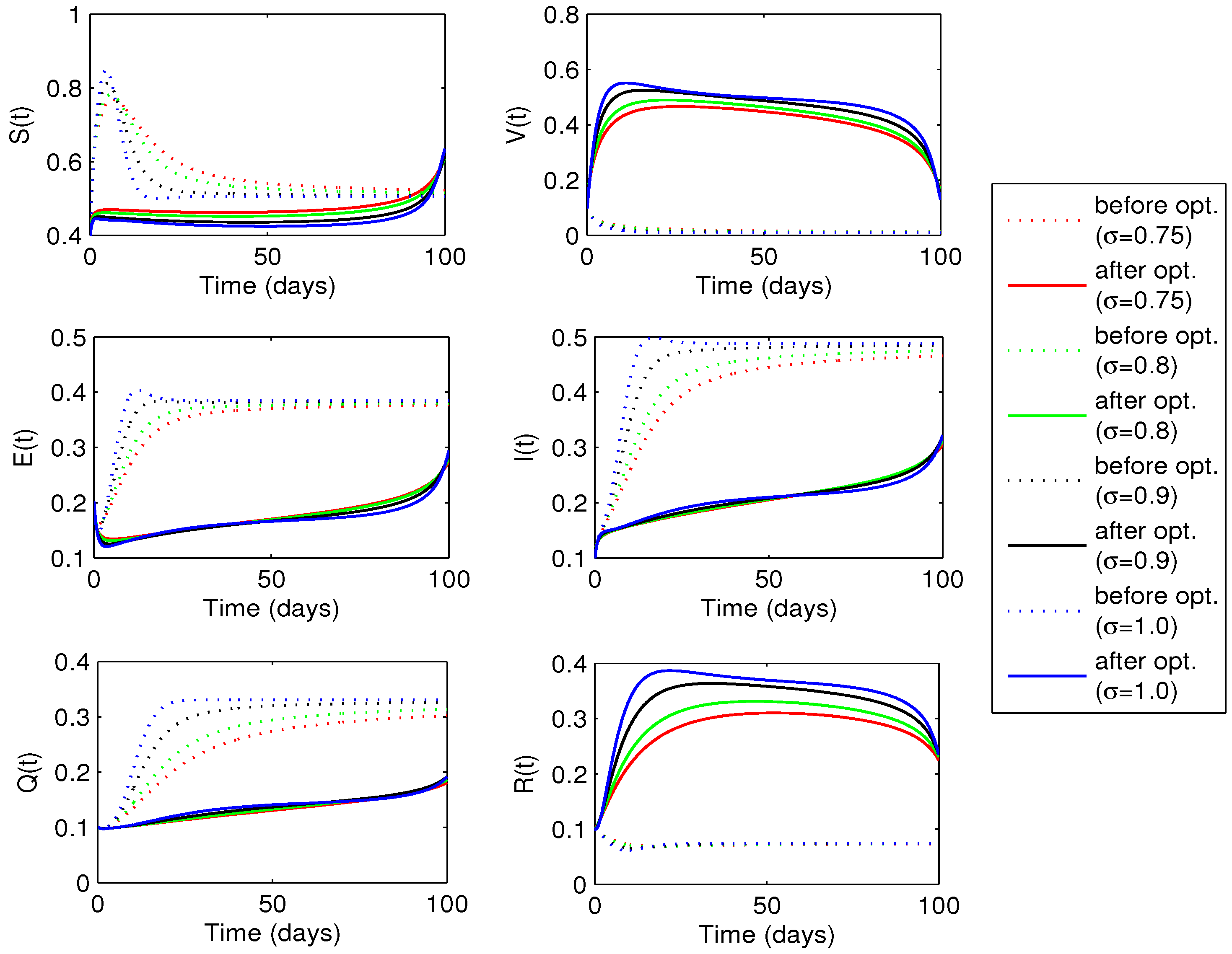
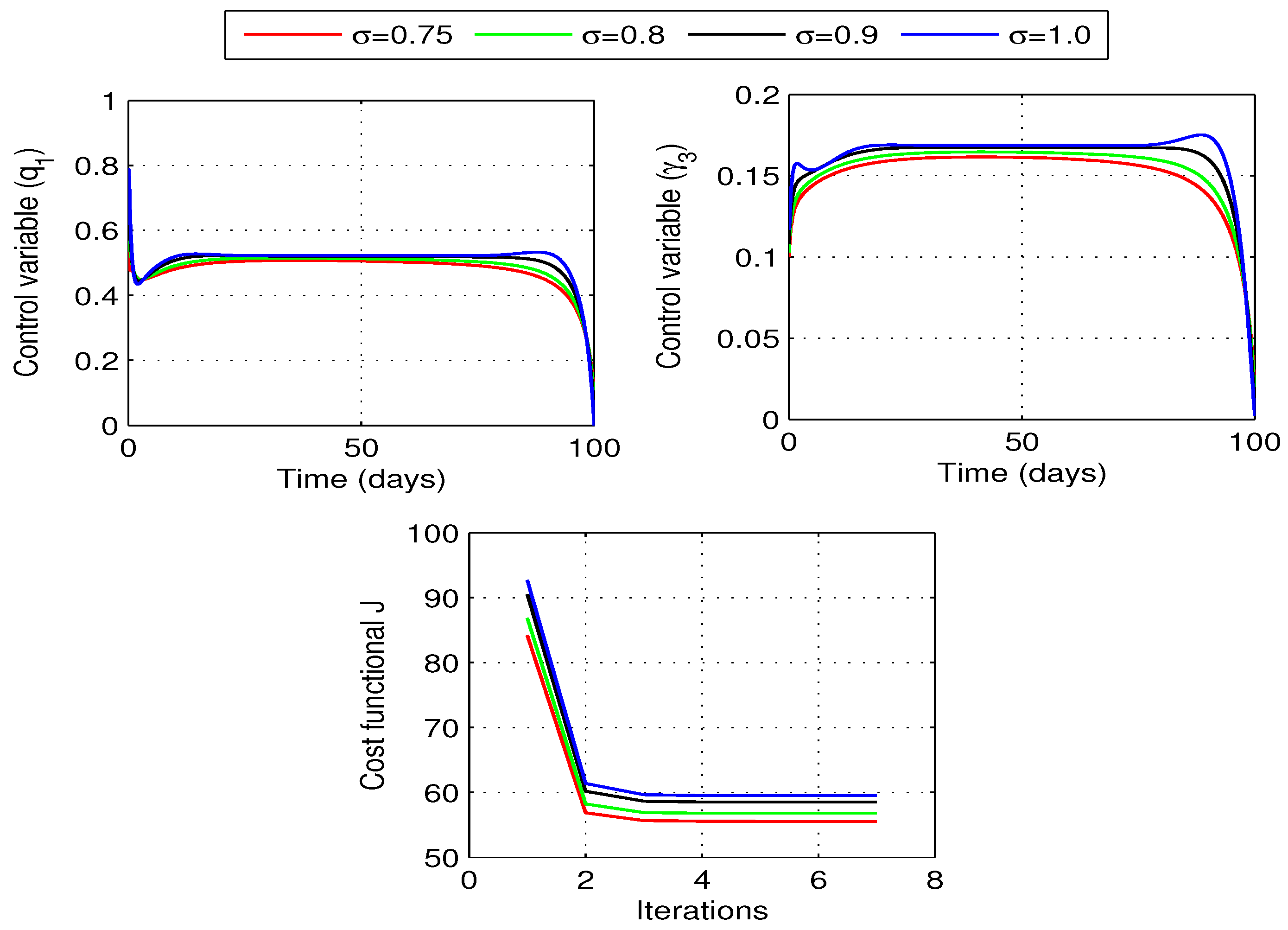
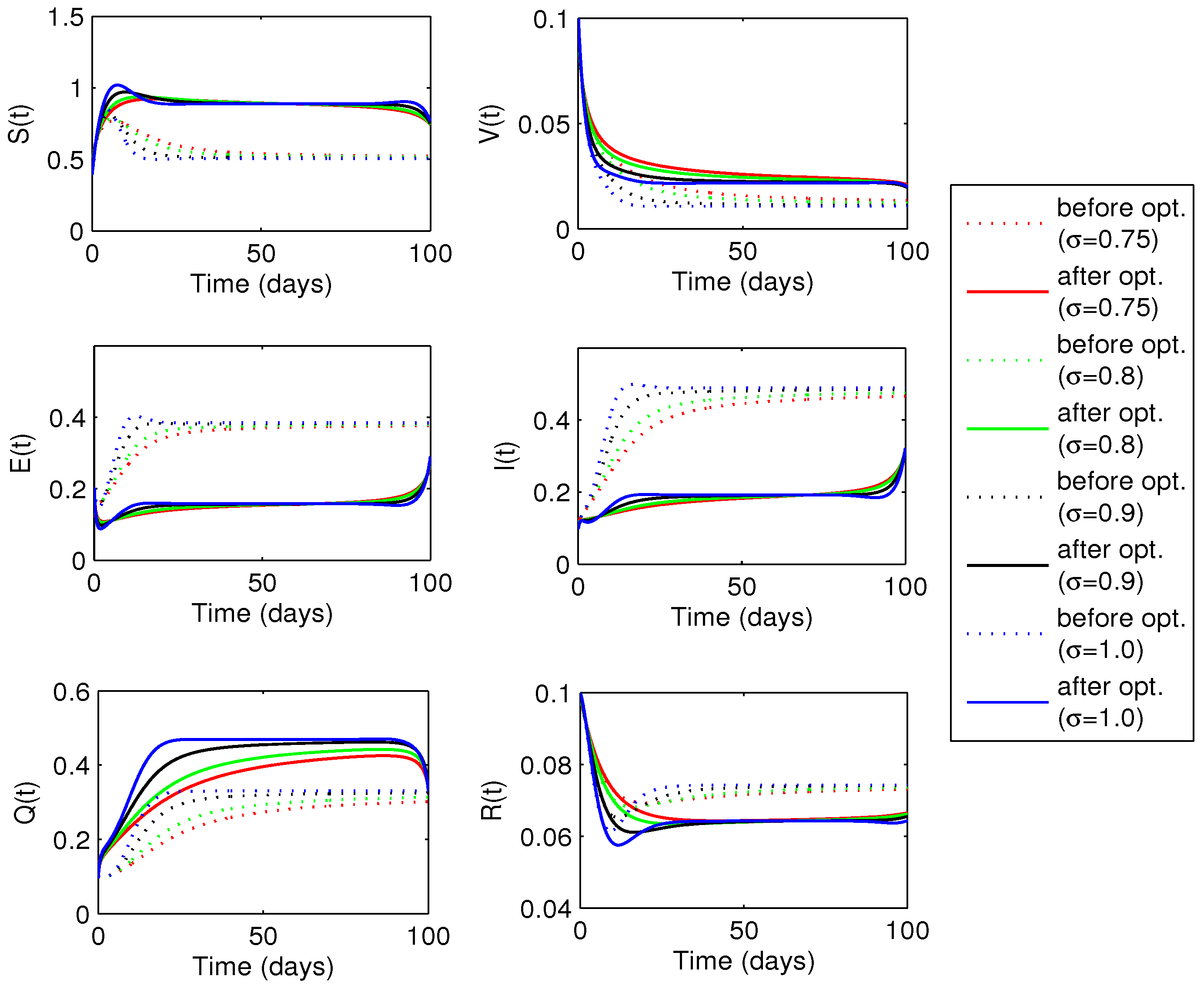
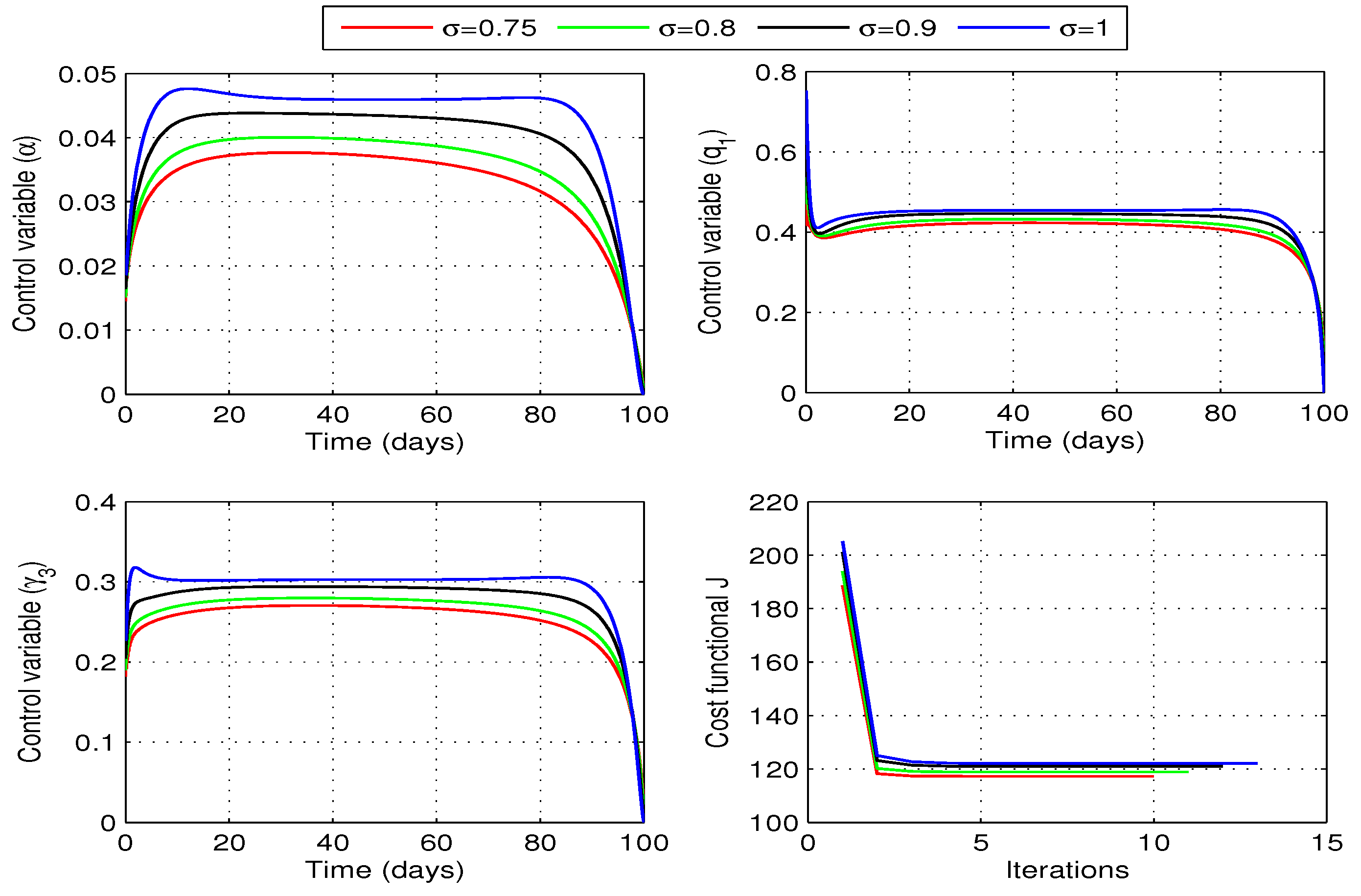
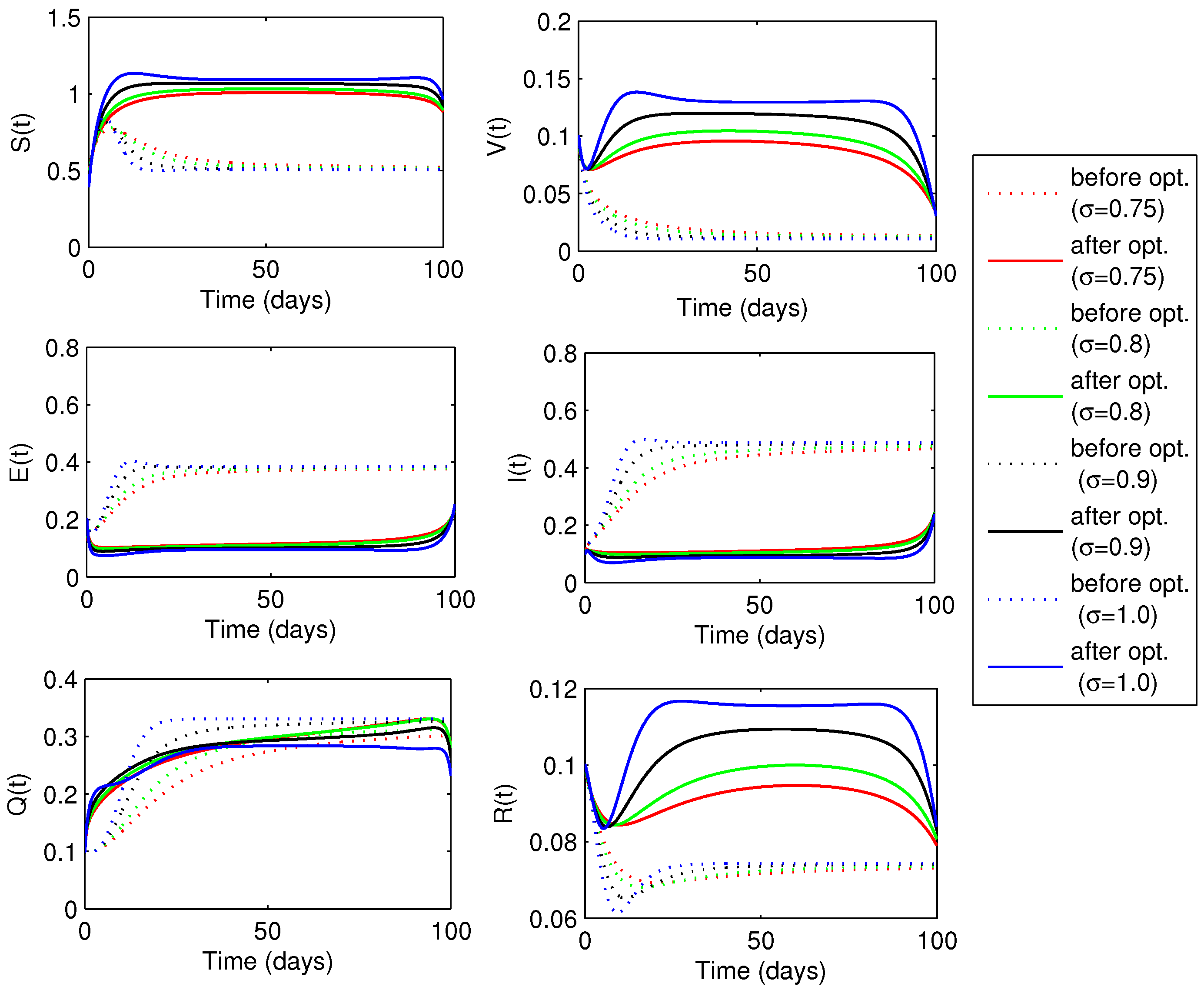
| Parameter | Sensitivity Index | Parameter | Sensitivity Index |
|---|---|---|---|
| 1.0000 | −1.8150 | ||
| −0.0388 | 0.9953 | ||
| 0.0046 | 0.3243 | ||
| −0.0018 | −0.0507 | ||
| −0.3807 | −0.0270 | ||
| −0.0101 | 0.0000 |
Disclaimer/Publisher’s Note: The statements, opinions and data contained in all publications are solely those of the individual author(s) and contributor(s) and not of MDPI and/or the editor(s). MDPI and/or the editor(s) disclaim responsibility for any injury to people or property resulting from any ideas, methods, instructions or products referred to in the content. |
© 2023 by the author. Licensee MDPI, Basel, Switzerland. This article is an open access article distributed under the terms and conditions of the Creative Commons Attribution (CC BY) license (https://creativecommons.org/licenses/by/4.0/).
Share and Cite
Butt, A.I.K. Atangana-Baleanu Fractional Dynamics of Predictive Whooping Cough Model with Optimal Control Analysis. Symmetry 2023, 15, 1773. https://doi.org/10.3390/sym15091773
Butt AIK. Atangana-Baleanu Fractional Dynamics of Predictive Whooping Cough Model with Optimal Control Analysis. Symmetry. 2023; 15(9):1773. https://doi.org/10.3390/sym15091773
Chicago/Turabian StyleButt, Azhar Iqbal Kashif. 2023. "Atangana-Baleanu Fractional Dynamics of Predictive Whooping Cough Model with Optimal Control Analysis" Symmetry 15, no. 9: 1773. https://doi.org/10.3390/sym15091773
APA StyleButt, A. I. K. (2023). Atangana-Baleanu Fractional Dynamics of Predictive Whooping Cough Model with Optimal Control Analysis. Symmetry, 15(9), 1773. https://doi.org/10.3390/sym15091773








